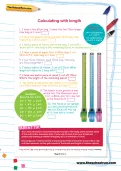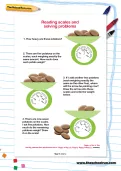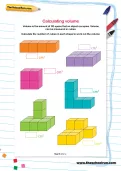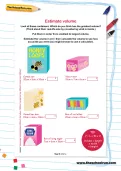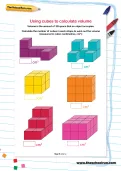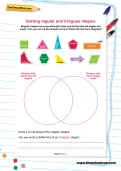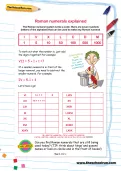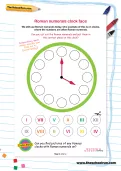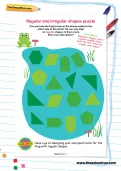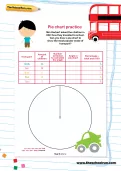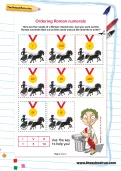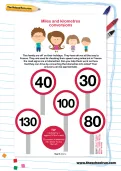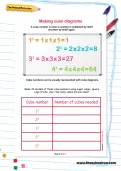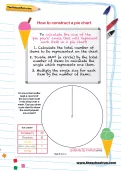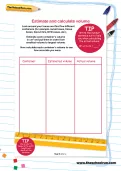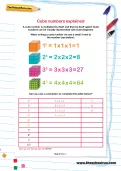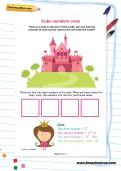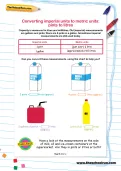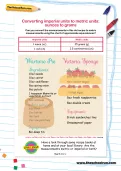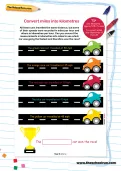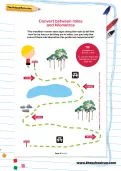Volume is the amount of 3D space that an object occupies. Calculate the number of cubes in each shape to work out the volume (measured in cubic centimetres, cm3).
or
Register to add to your saved resources
Already a subscriber? to view this content.
Regular shapes have equal-length sides and all the internal angles are equal. Can you cut out the shapes and sort them into the Venn diagram? Then draw a circle around the regular shapes and write a definition of an irregular shape.
or
Register to add to your saved resources
Can you complete this puzzle with the correct Roman numerals?
or
Register to add to your saved resources
The Roman numeral system is like a code: there are seven symbols (letters of the alphabet) that can be used to make any Roman numeral. To work out what the number is, just add the digits together! If a smaller numeral is in front of the larger numeral, you need to subtract the smaller numeral. Now you have a go...
or
Register to add to your saved resources
We still use Roman numerals today. One example of this is on clocks, where the numbers are often Roman numerals. Can you find pictures of any famous clocks with Roman numerals on?
or
Register to add to your saved resources
Already a subscriber? to view this content.
Can you help the frog to hop on the stones safely to the other side of the pond? He can only step on regular shapes. Is there more than one route option?
or
Register to add to your saved resources
Have fun with irregular shapes with this four-in-a-row game.
or
Register to add to your saved resources
Mrs Herbert asked the children in 6KH how they travelled to school. Can you draw a pie chart to show the most popular mode of transport?
or
Register to add to your saved resources
Already a subscriber? to view this content.
Here are the results of a Roman chariot race. Can you work out the Roman numerals then cut out the cards and put the chariots in order?
or
Register to add to your saved resources
This family are off on their holidays. They have driven all the way to France. They are used to checking their speed using miles but in France the road signs are in kilometres! Can you help them work out how fast they can drive by converting the kilometres into miles? Your answers can be approximate.
or
Register to add to your saved resources
Already a subscriber? to view this content.
A cube number is when a number is multiplied by itself and then by itself again. Cube numbers can be visually represented with cube diagrams. Make 3D models of these cube numbers using sugar cubes, square Lego bricks, clay. How many cubes did you need?
or
Register to add to your saved resources
Already a subscriber? to view this content.
An ice-cream seller kept a record of the ice-cream sold in his shop over a week. Can you draw a pie chart to show the most popular ice-cream?
or
Register to add to your saved resources
Look at these containers. Which do you think has the greatest volume? (Think about their real-life size by considering what is inside.) Put them in order from smallest to largest volume. Estimate the volume in cm3, then calculate the volume to see how accurate you were.
or
Register to add to your saved resources
Look around your house and find five different containers (for example cereal boxes, tissue boxes, biscuit tins, DVD cases, etc.). Estimate each container’s volume in cm3 and put them in order from smallest volume to largest volume. Now calculate each container’s volume to see how accurate you were.
or
Register to add to your saved resources
Already a subscriber? to view this content.
A cube number is multiplied by itself and then by itself again! Cube numbers can be visually represented with cube diagrams. When writing a cube number we use a small 3 next to the number. Can you use a calculator to complete the table below?
or
Register to add to your saved resources
Already a subscriber? to view this content.
There is a code on the door of the castle. Can you help the princess to work out the code so she can enter the castle?
or
Register to add to your saved resources
Already a subscriber? to view this content.
Capacity is measured in litres and millilitres. Old (imperial) measurements are gallons and pints; there are 8 pints in a gallon. Sometimes imperial measurements are still used today. Can you convert these measurements, using the chart to help you?
or
Register to add to your saved resources
Already a subscriber? to view this content.
Can you convert the measurements in this old recipe to metric measurements using the chart of approximate equivalences?
or
Register to add to your saved resources
Already a subscriber? to view this content.
All these cars travelled the same distance, but some of their speeds were recorded in miles per hour and others in kilometres per hour. Can you convert the measurements in kilometres into miles to see which car was going the fastest and therefore won the race?
or
Register to add to your saved resources
Already a subscriber? to view this content.
This marathon runner sees signs along the route to tell him how far he has run but they are in miles; can you help him convert them into kilometres (his preferred measurement)?
or
Register to add to your saved resources
Already a subscriber? to view this content.
